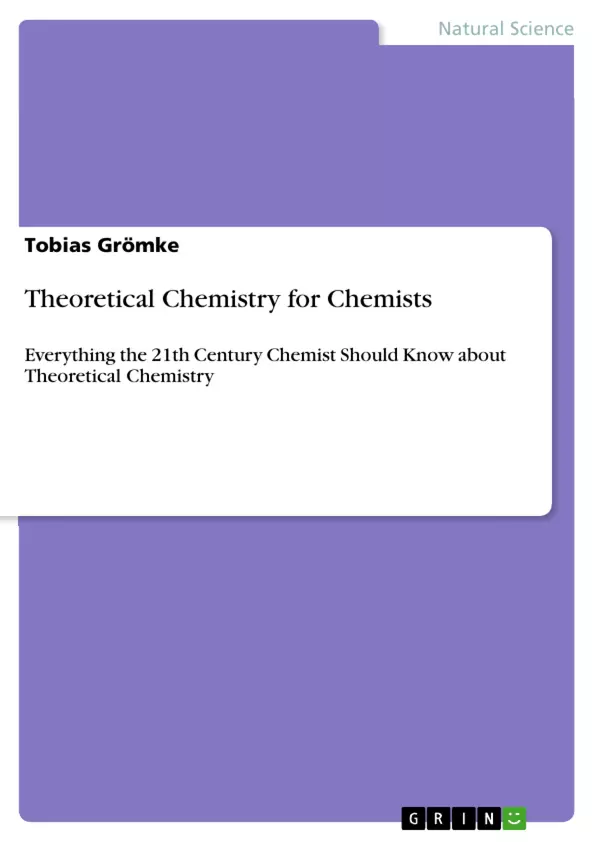This is a book for all chemists who don't want to become theoretical chemists, but who want to understand user articles and presentations with theoretical concepts included and who want to use theoretical chemistry for there own projects. It gives an overview about: Hartree Fock Theory, Post-Hartree-Fock-Methods, Density-Functional-Theory, Solid-State-Physics, Force-Field Methods and Molecular Dynamics.
Everything the chemist of the 21th century should know about Theoretical Chemistry, to be able to read articles with a satisfying yield of new informations, to be able to effectively talk to and work with theoretical chemists and to plan own calculations.
The author offers an overview about Post-Hartree-Fock-Methods (Coupled Cluster (incl. Example for Application of Perturbation-Theory), Full CI, explicitly correlated methods) Density-Functional-Theory (Basic Equations, reason of lower computational cost, important Types of Functionals (LSD-Functionals, GGA-Functionals, Hybrid-Functionals)), Important points in searching the right method), Force-Field-methods (Basic Theory, Basic Equations, practical tips as tool in quantum-chemical Calculations), theoretical Solid-State Physics (differences to quantum chemical equations, special behavior of solid-state-systems, atomic groups with single-particle-behavior – like phonons, polarons, ...), the role of special techniques (Perturbation Theory, Group Theory) and shows connections of those techniques to molecular dynamics.
For that he shows all necessary mathematics and derivations, when they are needed but just as deep as necessary. Not with the target to make the reader a theoretician. In front of the derivative part he commits his pictorial imagination of Hilbert-space, basis set, and quantum-chemical-calculations.
Inhaltsverzeichnis (Table of Contents)
- 0. PREFACE...
- 0.1. SHORT DESCRIPTION, TARGET AUDIENCE, REQUIRED PREKNOWLEDGE
- 0.2. INTRODUCTION TO THE USED PATHWAYS OF ARGUMENTATION AND EXAMPLES FOR THE NEED OF UNDERSTANDING MORE ABOUT THEORETICAL CHEMISTRY..
- 1. OVERVIEW ABOUT THEORETICAL-METHODS........
- 2. BASIS SET...
- 2.1. INTRODUCTION.....
- 2.2. PICTORIAL-IMAGINATION OF HILBERT-SPACE………………………………………..\n
- 2.3. ORTHOGONALITY AND RELATIVE BEHAVIOR BETWEEN DIFFERENT SOLUTIONS OF THE SCHRÖDINGER-EQUATION......
- 2.4. FIRST LOOK AT REAL BASIS-FUNCTIONS AND APPEARING INTEGRALS ....
- 2.5. THE SCHRÖDINGER-EQUATION FOR THE HYDROGEN-ATOM WITH A GAUSSIAN-ANSATZ. .
- 2.6. GROUND-PRINCIPLES OF MODERN BASIS-SET....
- 2.6.1. CONTRACTED-GAUSSIANS...
- 2.6.2. BASIC TERMS OF MODERN BASIS-SET............
- 3. POST-HARTREE-FOCK-METHODS.....
- 3.1. THE HARTREE-PRODUCT……………..\n
- 3.2. INTRODUCTION TO SLATER-DETERMINANTS AND PROPERTIES OF FUNCTIONALS .......
- 3.2.1. CONSTRUCTION OF SLATER-DETERMINANTS FROM SPIN-ORBITALS........
- 3.2.2. FUNCTIONALS...
- 3.3. HARTREE-FOCK-THEORY...
- 3.3.1. INTRODUCTION, DEEPENING OF OUR COMPREHENSION OF HILBERT-SPACE AND EIGENVALUE-EQUATIONS...
- 3.3.2. DERIVATION OF THE HARTREE-FOCK-EQUATIONS.........
- 3.3.3. THE HARTREE-FOCK-EQUATIONS…….......
- 3.4. APPLICATION OF THE HARTREE-FOCK-THEORY........
- 3.4.1. ROOTHAAN-HALL-EQUATIONS.......
- 3.4.2. OPEN-SHELL-CALCULATIONS, CONFIGURATION-INTERACTION, FULL-CI AND 1CORRELATION-ENERGY......
- 3.4.3. COUPLED-CLUSTER-THEORY AND INTRODUCTION TO APPLICATION OF PERTURBATION- THEORY..........\n
- 5. FUNDAMENTAL PRINCIPLES OF DENSITY-FUNCTIONAL-THEORY AND VARIATIONS OF DFT- METHODS....
- 6. OTHER THEORIES..\n
- 6.1. SEMI-EMPIRICAL-METHODS.….……..\n
- 6.2. QUANTUM-THEORY AND BASIS-SET IN SOLID-STATE-PHYSICS (AND ESOTERIC ☺...........
- 6.3. HOW TO FIND THE BEST THEORETICAL METHOD,.\nNECESSARY FOR MY DESIRED ANSWER AND HOW TO CHOSE THE OPTIMAL FUNCTIONAL\nFOR A DFT-CALCULATION WITH MY SYSTEM-PROPERTIES?
- 7. THE MOST IMPORTANT CONCLUSION FROM MODERN..\nTHEORETICAL-CHEMISTRY..\n
- 8. IMPORTANT CALCULATION-TYPES......
- 8.1. INTERACTION-ENERGY, POTENTIAL-ENERGY-SURFACES AND COUNTERPOISE-CORRECTION\n
- 8.2. GEOMETRICAL OPTIMIZATIONS VS. VARYING COEFFICIENTS FOR ENERGY-MINIMS IN\nOTHER CALCULATIONS,.......\nDEFINITION OF THE DIFFERENT VARIATIONS ......\nGEOMETRY-OPTIMIZATION....
- 8.3. DENSITY-CALCULATIONS AND OTHER POSSIBLE CALCULATIONS FOLLOWING THE\n
- 8.4. SPECTRA-CALCULATION; PRE-CALCULATIONS AND SIMPLIFICATION USING GROUP-\nTHEORY OF SYMMETRY-OPERATORS AND SYMMETRY-ELEMENTS, SYMMETRY-ADAPTED-\nMETHODS...\n
- 9. MOLECULAR DYNAMICS/MONTE-CARLO-SIMULATIONS AND FUTURE-PERSPECTIVES OF\nTHEORETICAL CHEMISTRY...\n
- 10. LITERATURE..\n
- 11. ACKNOWLEDGEMENTS...\n
Zielsetzung und Themenschwerpunkte (Objectives and Key Themes)
This book is intended for chemistry graduate students who are interested in understanding more about theoretical chemistry. It provides an overview of Post-Hartree-Fock-Methods, Density-Functional-Theory, Force-Field-methods, theoretical Solid-State Physics, and other important techniques like Perturbation Theory and Group Theory.
- Understanding the basis set and its influence on quantum chemical calculations
- Learning about different theoretical methods and their applications
- Exploring the connection between theoretical chemistry and molecular dynamics
- Gaining insights into the future perspectives of theoretical chemistry
- Understanding the importance of theoretical chemistry for the development of chemistry
Zusammenfassung der Kapitel (Chapter Summaries)
The book starts with an introduction to the used pathways of argumentation and examples for the need of understanding more about theoretical chemistry. The following chapters delve into the basis set, a fundamental concept in theoretical chemistry. Chapter 2.1 introduces the basis set, while chapter 2.2 explores the pictorial imagination of Hilbert-space. The subsequent chapters address orthogonality and the behavior of different solutions of the Schrödinger-equation, the Schrödinger-equation for the hydrogen-atom with a Gaussian-Ansatz, and ground-principles of modern basis-set, including contracted-Gaussians and basic terms of modern basis-set. Chapter 3 focuses on Post-Hartree-Fock-methods, including the Hartree-product, Slater-determinants, and the Hartree-Fock-theory.
Schlüsselwörter (Keywords)
This book focuses on theoretical chemistry, covering topics such as the basis set, Hilbert-space, the Schrödinger-equation, Post-Hartree-Fock-Methods, Density-Functional-Theory, Force-Field-methods, theoretical Solid-State Physics, Perturbation Theory, Group Theory, and molecular dynamics.
- Citar trabajo
- Tobias Grömke (Autor), 2016, Theoretical Chemistry for Chemists, Múnich, GRIN Verlag, https://www.grin.com/document/373462



